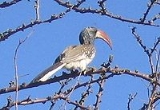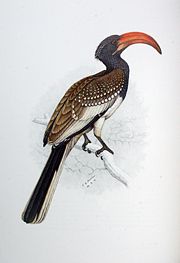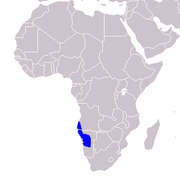
Monteiro's Hornbill
Encyclopedia


Hornbill
Hornbills are a family of bird found in tropical and subtropical Africa, Asia and Melanesia. They are characterized by a long, down-curved bill which is frequently brightly-colored and sometimes has a casque on the upper mandible. Both the common English and the scientific name of the family...
. It is a medium sized bird, with a length between 54 to 58 cm, characterized by a white belly, black back, with white spots on the wings and secondary flight feathers coloured white. The outer feather
Feather
Feathers are one of the epidermal growths that form the distinctive outer covering, or plumage, on birds and some non-avian theropod dinosaurs. They are considered the most complex integumentary structures found in vertebrates, and indeed a premier example of a complex evolutionary novelty. They...
s of the long tail are also white.
Females are smaller than males and can be recognized by turquoise facial skin. The eyes are black and the beak is red. Unlike other members of the family, which are omnivorous
Omnivore
Omnivores are species that eat both plants and animals as their primary food source...
, the Monteiro's hornbill feeds exclusively on insect
Insect
Insects are a class of living creatures within the arthropods that have a chitinous exoskeleton, a three-part body , three pairs of jointed legs, compound eyes, and two antennae...
s and other small arthropod
Arthropod
An arthropod is an invertebrate animal having an exoskeleton , a segmented body, and jointed appendages. Arthropods are members of the phylum Arthropoda , and include the insects, arachnids, crustaceans, and others...
s. Its habitat is the savanna
Savanna
A savanna, or savannah, is a grassland ecosystem characterized by the trees being sufficiently small or widely spaced so that the canopy does not close. The open canopy allows sufficient light to reach the ground to support an unbroken herbaceous layer consisting primarily of C4 grasses.Some...
h and dry thorn fields of NW Namibia
Namibia
Namibia, officially the Republic of Namibia , is a country in southern Africa whose western border is the Atlantic Ocean. It shares land borders with Angola and Zambia to the north, Botswana to the east and South Africa to the south and east. It gained independence from South Africa on 21 March...
.
In springtime, Monteiro's hornbills migrate to the southern Windhoek
Windhoek
Windhoek is the capital and largest city of the Republic of Namibia. It is located in central Namibia in the Khomas Highland plateau area, at around above sea level. The 2001 census determined Windhoek's population was 233,529...
region for nesting. Due to the arid environment, drinking is not a vital necessity for this species. They breed in the end of good rainy season, laying 3 to 5 white-greyish eggs
Egg (biology)
An egg is an organic vessel in which an embryo first begins to develop. In most birds, reptiles, insects, molluscs, fish, and monotremes, an egg is the zygote, resulting from fertilization of the ovum, which is expelled from the body and permitted to develop outside the body until the developing...
, hatched after about 45 days. The nest is built in rocky faces or trees. The Monteiro's hornbill is a common endemic species of Namibia, with total population estimated on 340,000 individuals.

